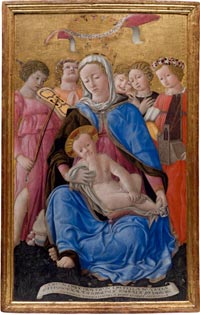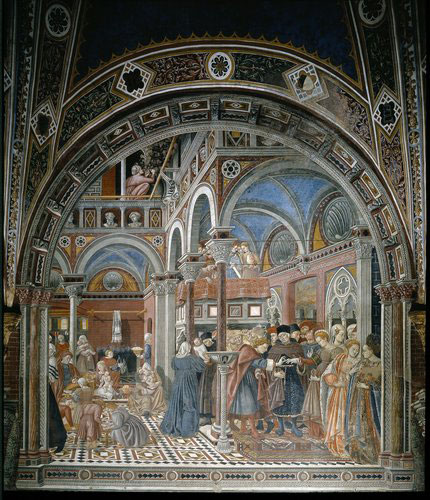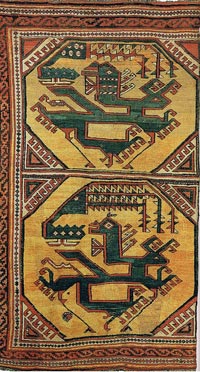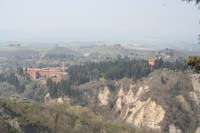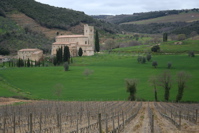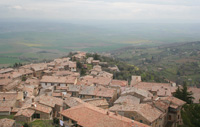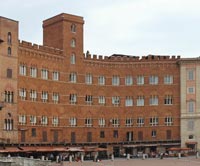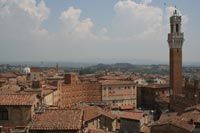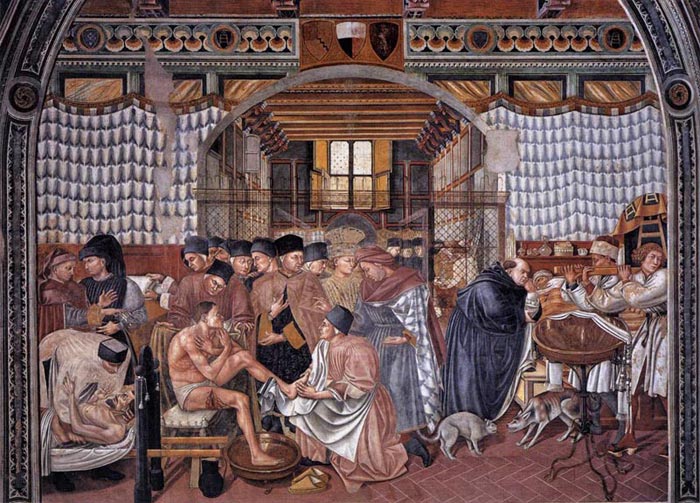 |
|
Healing the sick, fresco by Domenico di Bartolo. Sala del Pellegrinaio (hall of the pilgrim), Hospital Santa Maria della Scala, Siena |
|
Domenico di Bartolo |
| Domenico di Bartolo (c. 1400/1404 – 1445/1447) was an Italian painter of the Sienese School. He was born in Asciano. According to Vasari, he was a nephew of Taddeo di Bartolo. He was born in Asciano. In the early 1400s, the Sienese artist most influenced by the new Florentine style of painting was Domenico di Bartolo. He was, in fact, the only Sienese painter of his day to receive commissions from Florentine clients. Domenico di Bartolo was employed by Vecchietta in the masterpiece fresco The Care of the Sick in the Pellegrinaio (Pilgrim's Hall) of the Ospedale di Santa Maria della Scala in Siena. It portrays wealthy donors visiting the hospital to men washing the ill, and a fatty friar hearing confession. He painted one of the most beautiful panels of the Early Renaissance, the Madonna dell' Umiltà. It is signed and dated 1433 and is one of the earliest truly Masaccesque paintings for which we have a firm date. Domenico di Bartolo must have had some crucial experience in Florence in the 1420s, because his Virgin of Humility of 1433 reveals close connections with the art of Donatello, Masa&ccio, Luca della Robbia, and Filippo Lippi. Domenico di Bartolo's major surviving achievement is his participation in a series of frescoes in the Pellegrinaio, the hall for pilgrims at Siena's Hospital of Santa Maria della Scala. The Frescoes have unusual secular subjects, which deal with the charitable, civic, and medical activities of the hospital. The Gothic vaulting of the room determined the arched openings. The settings are sometimes the rooms of the hospital itself. In their naturalism and their wealth of imagery drawn from contemporary life, these frescoes provide remarkable insight into Sienese activities. In 1434, Domenico di Bartolo also painted a fresco panel of Emperor Sigismund Enthroned for the Siena Cathedral. He was the tutor of Piero della Francesca. Domenico died in Siena around 1445. | ||
The Madonna dell' Umiltà |
||
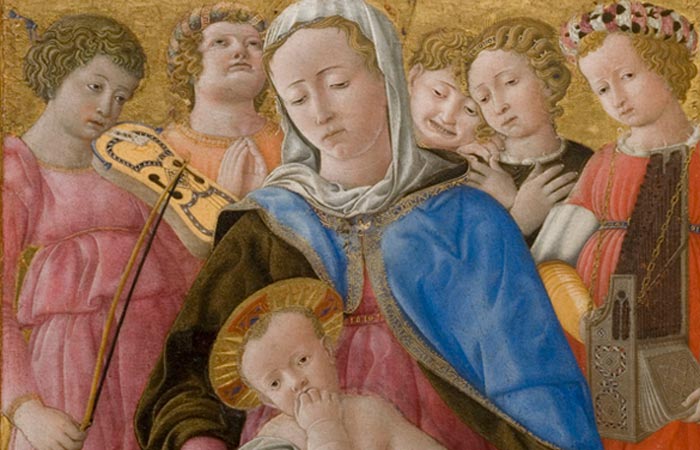 |
||
Domenico di Bartolo, Madonna dell’umiltà, Siena, Pinacoteca Nazionale |
||
The impact of Masaccio's new vision had a limited impact on Siena, since for the most part, Siena maintained a distinct stylistic tradition of its own. A Sienese artist who does seem to have been affected by Masaccio, perhaps mediated by the art of Filippo Lippi, is Domenico di Bartolo. His art is exemplified by this signed and dated work of 1433, which contains passages of trompe l'oeil including the banderole with writing on it. The grouping of the figures and the roundness of the faces, particularly the one of the angel who tilts his head sharply, are reminiscent of Filippo Lippi's painting in Empoli. |
||
| Domenico di Bartolo's fame is tied to the fresco cycle in the Pellegrinaio (pilgrims’ ward) of the hospital of Santa Maria della Scala in Siena (1440-1444), where he recounts the history and life of the hospital in an artistic language that ranges from International Gothic overtones to compositions showing a Flemish realism. Many great Sienese artists worked for Santa Maria della Scala at some time, making it the city's third important centre of art, together with the Duomo (cathedral) and the Palazzo Pubblico (Town Hall). But the most prestigious example of Sienese art in the Santa Maria della Scala complex, is the Pellegrinaio ward or 'pilgrims' hospice', built in the second half of the 14th century and decorated almost a century later with an important fresco cycle devoted to the history of the hospital. Artistic Treasures include a famous fresco cycle (now lost) with Histories of the Virgin, on the façade, by Simone Martini, Ambrogio and Pietro Lorenzetti (1335); the series of frescoes with the Stories of the Hospital in the Pellegrinaio Hall, by Domenico di Bartolo and Lorenzo Vecchietta. Domenico di Bartolo's frescoes have unusual secular subjects, which deal with the charitable, civic, and medical activities of the hospital. The Gothic vaulting of the room determined the arched openings. The settings are sometimes the rooms of the hospital itself. In their naturalism and their wealth of imagery drawn from contemporary life, these frescoes provide remarkable insight into Sienese activities. In the six bays of the hall, two frescoes on the east wall (The Enlargement of the Hospital; Extension of Privileges by Celestine III), and four on the north wall (Feeding of the Poor; Raising and Marrying of Orphans; Reception of Pilgrims and Distribution of Alms; Caring for the Sick) were executed by Domenico di Bartolo. |
 Santa Maria della Scala served as a hospital Santa Maria della Scala served as a hospital from the 10th Century until 1996. |
|
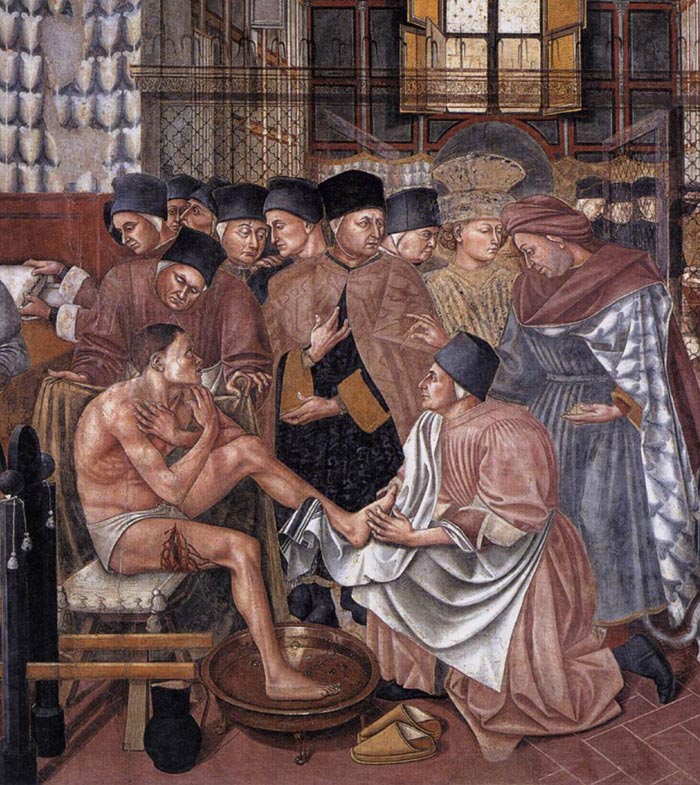 |
||
Domenico di Bartolo, Care of the Sick, 1441-42, fresco in Spedale di Santa Maria della Scala, Siena |
||
| In the Care of the Sick Domenico combines specific portraiture with a sensitive treatment of the nude figure. The unidealized bodies of the sick man being placed in bed and the wounded man being washed rank among the most naturalistic figures in Quattrocento painting. | ||
|
||
 |
||
Domenico di Bartolo, Almsgiving, ca. 1444, fresco in Pellegrinaio of the Ospedale di Santa Maria della Scalla, Siena |
||
The Rearing and Marriage of Female Foundlings |
||
This fresco The Rearing and Marriage of Female Foundlings is located on the west wall of the Pellegrinaio in the Spedale di Santa Maria della Scala. The painting combines two sacraments: matrimony and almsgiving.
|
||
Madonna and Child Enthroned with Saint Peter and Saint Paul, c. 1430. Samuel H. Kress Collection This small panel is one of the first in Siena to reflect the innovations of the Florentine painter Masaccio. Masaccio used light and perspective to give his figures weight and three-dimensionality, a sense of being in a space rather than simply on a painted surface. Domenico lit his scene from a source that comes strongly and consistently from the upper left, giving his Virgin and child a tactile reality. Their halos, tilted in perspective, help define the space. So does the niche behind them, which is inspired by ancient architecture. Domenico's use of light, perspective, and classical motifs suggest that he painted this after seeing the work of Masaccio and others in Florence. He is unlikely to have studied there, however; other elements of his work are typically Sienese, for example, the bright pastel pinks for the niche. Domenico's experiments were not taken up by his contemporaries, but they did influence artists in the next generation.'[1] |
||
[1] Madonna and Child Enthroned with Saint Peter and Saint Paul (c. 1430) - Tempera on panel, 53 x 31 cm, National Gallery of Art, Washington, USA [2] Oriental carpets in Renaissance painting | Carpets of Middle-Eastern origin, either from the Ottoman Empire, the Levant or the Mamluk state of Egypt or Northern Africa, were used as important decorative features in paintings from the 14th century onwards. Such carpets were often integrated into Christian imagery as symbols of luxury and status of Middle-Eastern origin, and together with Pseudo-Kufic script offer an interesting example of the integration of Eastern elements into Renaissance painting and of Islamic influences on Christian art. Most carpets use Islamic geometric designs, with the earliest ones also using animal patterns such as the originally Chinese-inspired "phoenix-and-dragon", as in Domenico di Bartolo's Marriage of the Foundlings (1440). These had been stylised and simplified into near-geometric motifs in their transmission to the Islamic world. They have disappeared from paintings by about the end of the 15th century. Only a handful of original animal-pattern carpets survive, mostly also from European churches, where their rarity presumably preserved them. |
||
| This page uses material from the Wikipedia article Domenico di Bartolo, published under the GNU Free Documentation License. Wikimedia Commons has media related to: Domenico di Bartolo. |
||
|
Holiday accomodation in Tuscany | Podere Santa Pia | Artist and writer's residency |
||||
Podere Santa Pia |
Podere Santa Pia, garden view, December |
View from terrace with a stunning view over the Maremma and Montecristo |
||
Monte Oliveto Maggiore abbey |
Abbey of Sant 'Antimo |
Montalcino |
||
Siena, duomo |
Siena, Palazzo Sansedoni |
Siena, Piazza del Campo |
||
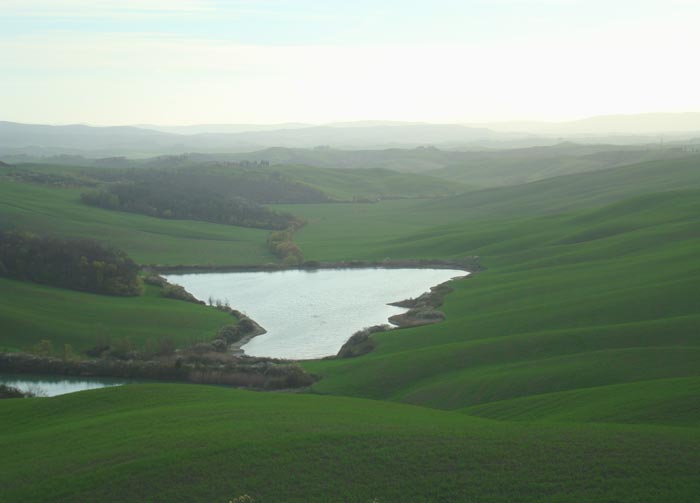 |
||||
Crete Senesi, surroundings of Podere Santa Pia |
||||
The location of Podere Santa Pia is unique and the landscape a once-in-a-life sight. Although this is off the beaten track it is the ideal choice for those seeking a peaceful, uncontaminated environment. The guesthouse is located in Castiglioncello Bandini, a charming medieval village situated on a hill, which offers a spectacular view on the Valle dell’Ombrone and the Maremma. Montalcino, the abbey of Sant'Antimo, Pienza and the Crete Senesi with Asciano, Buenvonvento and the Abbey Di Monte Oliveto Maggiore are within easy reach. |
||||

